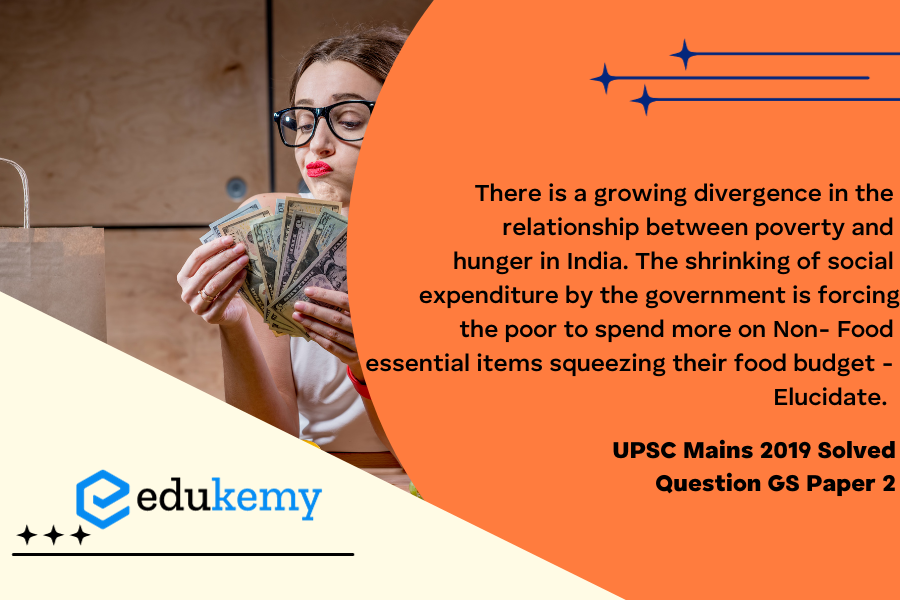In contemporary India, an alarming trend is surfacing that underscores a burgeoning disconnect between poverty and hunger. This disjunction is primarily attributed to the contracting scope of social expenditure by the government, pushing the impoverished populace into a precarious situation. The ramifications of this fiscal reduction manifest in an augmented burden on the economically disadvantaged, compelling them to allocate an increasing proportion of their limited resources to non-food essential items. As a consequence, the fragile equilibrium of their household budgets is disrupted, resulting in a constricted allocation for the most basic necessity—food. The deliberate contraction of social spending exacerbates the challenges faced by those already grappling with poverty, transforming their struggle for sustenance into an even more formidable ordeal. This intricate interplay between government policy and individual household dynamics highlights a pressing concern: the vulnerability of the poor to external economic forces and policy decisions. In this elucidation, we delve into the multifaceted dimensions of this phenomenon, scrutinizing the implications of reduced social expenditure on the intricate web of poverty, hunger, and household economies in India.
Tag: Issues relating to poverty and hunger.
Contents
Decoding the Question:
- In the Introduction, try to write the expenditure of the government on the social sector and compare it with other countries.
- In Body,
- Write about the growing divergence in the relationship between poverty and hunger in India.
- Discuss the food-budget squeeze hypothesis in India.
- In Conclusion, try to suggest some measures to address the issue.
Answer:
India spends less on social sector schemes; the government spends only 2.3 % of GDP on health which is less than the world average of 10.02%. In the education sector, the total spending is 3.4% against the world’s average of 4.815%. The low social expenditure of the government reduces human capital formation and leads people to divert their resources from food items to non-food items.
Despite an increase in the real income of the people over the last two decades, overall calorie consumption and nutritional intake has not commensurately increased. According to the Global Hunger Index, India is second after South Sudan, when it comes to wasting (low weight for height) among children. Also, there are millions of children and adults suffering from “Hidden Hunger”.


Divergent Relation Between Poverty and Hunger:
- According to the data released by the Planning Commission in mid-2012, the overall HCR has declined by another eight percentage points to 22% in just two years.
- The prevalence of hunger in India is still higher. The proportion of undernourished persons in urban India, i.e., those consuming less than 2,100 kcal per day, was already high at 58% in 1993-94; it climbed to 70% in 2009-10.
Food Budget Squeeze Hypothesis:
- India is experiencing a condition of food-budget squeeze, owing to shrinking social expenditure by the government.
- This increases the dependence of urban and rural poor on private entities for essential services like education and transportation, which are expensive. Thus, the portion of income that can be spent on food is shrinking.
- The poor, rather than being a matter of choice, have been increasingly forced to spend more on non-food essential items such as healthcare, education, transportation, fuel, etc.
- Possibly, the most important reason for this is shrinking social expenditure by the government which is rendering the urban and the rural poor dependent on market prices of non-food essential items, like education, healthcare, etc which are typically high.
- It has several detrimental consequences such as malnutrition, stunting, wasting, low immunity, high death rate, hygiene issues, etc.
- Simultaneous nations lack in generating human capital, skilled labor, life expectancy, etc., which may affect the economy and society of a country.
Hunger persists in India also because of a decline in access to non-market food sources, preference for ‘better tasting more expensive calories and increased spending on luxury items like radio, TV, and mobile phones, as economist Abhijit Banerjee writes in his book – “Poor Economics”.
Hunger is the leading cause of death in the world. A substantial push in public provisioning towards social protection and mobilizing adequate resources for the provisioning of social protection might go a long way in ensuring food security in India. Economists Amartya Sen and Jean Dreze distinguish two aspects of social security — “protection” and“promotion”. While the former denotes protection against a fall in living standards through ill health, and accidents; the latter focuses on enhanced living conditions- “capability building”.The government needs to take care of these by increasing expenditure on education upto 6% of GDP as recommended by the Kasturirangan committee and meet the target of spending 2.5% of GDP on health helping the poor to focus on nutrition.
In case you still have your doubts, contact us on 9811333901.
For UPSC Prelims Resources, Click here
For Daily Updates and Study Material:
Join our Telegram Channel – Edukemy for IAS
- 1. Learn through Videos – here
- 2. Be Exam Ready by Practicing Daily MCQs – here
- 3. Daily Newsletter – Get all your Current Affairs Covered – here
- 4. Mains Answer Writing Practice – here


